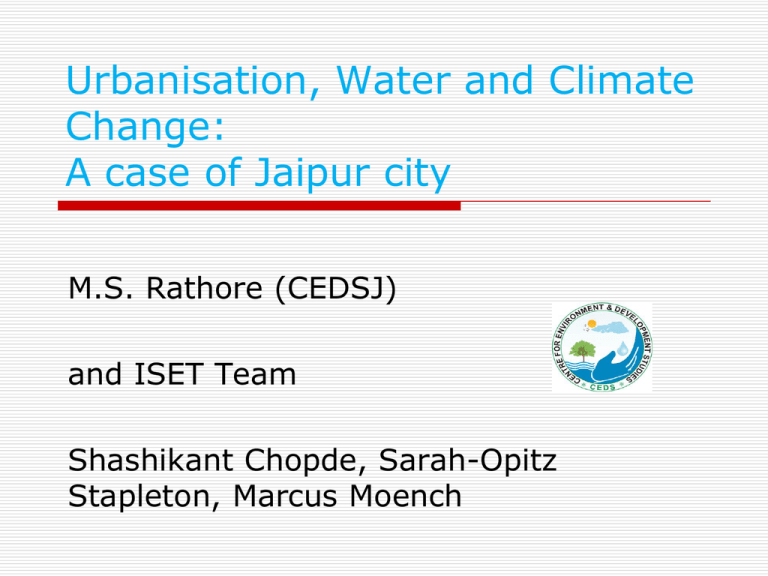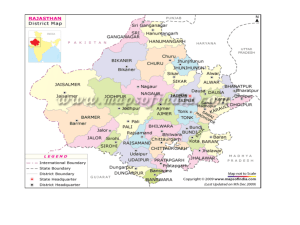Urbanisation, Water Scarcity and Climate Change - Hrdp
advertisement

Urbanisation, Water and Climate Change: A case of Jaipur city M.S. Rathore (CEDSJ) and ISET Team Shashikant Chopde, Sarah-Opitz Stapleton, Marcus Moench Context… India rapidly urbanising Urban areas engine of economic development Pressures: Push and pull migration from rural areas Climate Change—exacerbate challenge of water supply and protecting ecosystems Context Challenge: Meeting water supply demand of increasing urban population Relation between Climate Change and water resource conditions Nature and size of migrant population Deliver water supply to poor/ vulnerable where there is lack of infrastructure Jaipur City High rural-urban migration rates Rapidly expanding peri-urban areas: Land use changes reducing recharge Limited water supply and water quality issues Groundwater over-extraction, pollution and less recharge The key surface water sources (Bisalpur Dam) filled only few times High rainfall variability in Banas Basin; drought years common So, CC impacts—delay in monsoon, high intense showers over short period, dry years poses additional challenge to key surface water supplies Factors of Human Migration Changing Status of groundwater in Rajasthan Category 1984 1988 2001 2004 2008 Over Exploited (>100%) 22 (9.3) 41 (17.0) 86 (36.0) 140 (59.3) 164 (69.5) Critical (90 to 100%) 6 (2.5) 26 (11.0) 80 (34.0) 50 (21.2) 34 (14.4) Semi critical (70 to 90%) 27 (11.5) 34 (14.0) 21 (9.0) 14 (5.9) 8 (3.4) Safe (70%) 181 (76.7) 135 (57.0) 49 (21.0) 32 (13.6) 30 (12.7) Banas River Basin Total Free Catchment Area and Live Storage Capacity of Existing Irrigation Dams in Banas River Basin, Rajasthan Type of Scheme Number of Projects Free Catchment Area, Km2 Live Storage Mm3 Major 7 6,133 425 Medium 33 11,337 816 Minor 1219 16,496 1,055 Total 1259 33,965 2,296 Frequency of occurrence of drought and its intensity since 1901-2006 in the Banas River Basin Districts of Intensity and frequency of Drought Per cent of Total Year Normal years Very Severe Severe Moderate Light Pali 8 12 19 15 50.9 52 Jaipur 11 12 17 10 47.2 56 8 16 14 14 49.1 54 Tonk 9 11 11 18 46.2 57 Swai Madhopur 8 8 15 23 50.9 52 Bhilwara 3 9 10 15 37.0 63 Chittorgarh 10 12 12 13 44.3 59 10 14 14 9 44.3 59 Bundi 7 16 15 13 48.1 55 Average of Basin 8 12 14 15 46.4 57 Overall Rajasthan 10 10 15 15 47.2 56 Year wise Water Balance in Bisalpur Dam. (in TMC) Years 1994-95 1995-96 1996-97 1997-98 1998-99 1999-2000 2000-2001 2001-2002 2002-2003 2003-2004 2004-2005 2005-2006 2006-2007 2007-2008 Total collection of water(TMC) Total Use 0.100 0.790 1.630 1.850 1.410 3.630 8.120 14.000 5.800 7.770 38.700 28.390 38.700 22.252 0.100 0.790 1.140 1.490 1.410 2.570 4.960 8.800 4.270 5.290 17.090 17.690 21.750 14.768 Water Used (TMC) Irrigation Drinking 0.420 0.300 1.250 5.980 7.380 9.852 8.218 0.002 0.500 0.640 1.200 1.260 1.300 1.650 3.590 1.860 2.715 1.810 2.620 2.570 1.630 Evaporation Losses 0.098 0.290 0.500 0.290 0.150 0.850 3.010 3.960 2.410 2.575 9.300 7.690 9.326 4.920 The Project CEDSJ and ISET: Urbanisation, Water Scarcity and Climate Change: A case of Jaipur city Links between Climate Variability, Groundwater Overdraft and migration inflows Methodology Review of literature and policies Details surveys of migration Climate Downscaling for Banas River Basin: projected monthly time series of precipitation (2009-2040) Water Evaluation and Planning (WEAP) model: Current and future water availability and demand scenarios Climate Downscaling Two GCMs (CGCM3 and ECHAM5) Two emission scenarios (A1B and A2) Hence four climate change scenarios are considered namely CGCM3 A1B, CGCM3 A2, ECHAM5 A1B, and ECHAM5 A2 Common SRES emission scenarios (Source: Environment Canada 2011). WEAP setup for Jaipur water supply system Variance in Bisalpur storage (MCM) Huge unmet demand even without Climate Change Jaipur Combined: Domestic, Industrial uses Key Findings.. Sequential drought years Failure of current water supply system for urban demand Ability to respond dependant on availability of key data sets Official estimates of river flows differ greatly between two data sets Challenge to assess future water availability given uncertainty in CC projections Key Findings.. Reliable future streamflow record generation a challenge given the data available Hence, factors contributing to vulnerability of Jaipur were assessed. High dependence on single water supply source High Losses in distribution systems Extensive pollution and degradation of ecosystems and groundwater Options for resilient water supply system for Jaipur Water supply diversification Improved efficiency of water supply delivery Improved maintenance of ecosystems and local watersheds Recharge of aquifers in peri-urban areas and Groundwater management Policy: Strict enforcement of Landuse and revision of Masterplan Thank You ! msr@cedsj.org schopde@i-s-e-t.org











